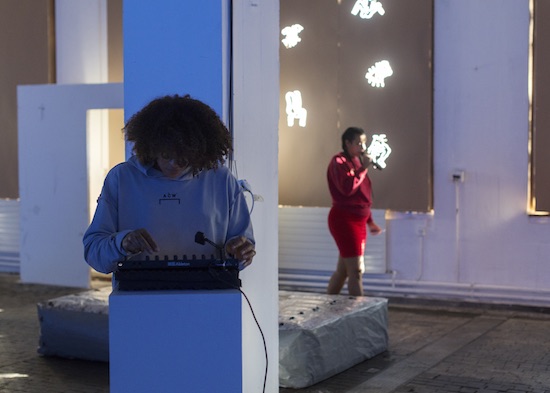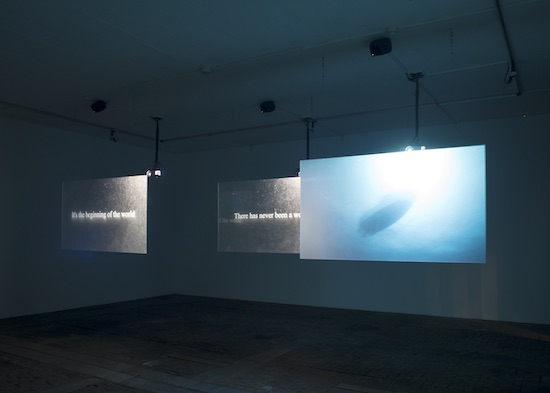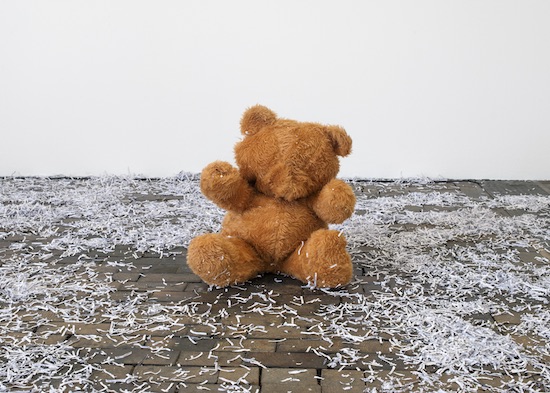Hannah Black, The Situation, 2017 & Transitional Objects, 2017. Exhibition view of ANXIETINA by Hannah Black, Bonaventure & Ebba Fransén Waldhör at Centre d’Art Contemporain Genève, 2018. Courtesy of the artists. Photo : Charlotte Krieger
With only snatches of words and fragments of sentences clearly audible above the electronic music, Hannah Black paces the floor, moving between the audience seated on big, bouncy seats and the inflatable mock brick walls and crumbling edifices that are normally used in military training.
The music is captivating, with the occasional familiar melody – classical tunes from ads, perhaps? or bursts of disco – weaved into the rhythmic, pulsing mix. The lighting effects go through a warm spectrum, and the space resembles a video game mock-up. Apocalypse appears to be the theme – some kind of post-catastrophe, post environmental fall-out, post military industrial complex, post-civilisation scenario. And the theme is underscored by the animated images playing on a loop on the three or four desk-top screens lighting up the darker corners of the room, inside the ruins of this mock fortress.
As the performance goes on, producer Bonaventure (Soraya Lutangu) loosens up her limbs, getting on down at her keyboard. Black delivers her monologue into a mic. In the other hand she holds her mobile phone, consulting it frequently. In fact, she doesn’t quite pace, since her stride isn’t particularly purposeful. She moves like she’s concentrating on just getting those words out. Her phone is her prompt, but it’s clearly also a prop, and she’s not so much performing the words as reeling them off. The words, flatly delivered, are tightly packed; there’s not much breathing space between them. When she’s finished, she runs to the exit mid-applause.
Perhaps this performance, almost an hour long, shouldn’t have worked, but the set, the lighting, the music, the wandering figure of Black herself, create an enveloping mood. Fragments amid the concatenation of lost words, linger in the air, conveying yearning, loss, the promise of hedonistic deliverance, the longing to lose oneself, a sense of nostalgia, raw and stripped of sentimentality. You sense layers of meaning you can’t yet grasp.
The performance was a one-off for the opening of Black’s exhibition at the Centre d’Art Contemporain Genève, a contemporary art space housed on multiple floors in a low-rise former industrial unit, whose narrow stairwell wraps around an impressive caged lift shaft. The installation for the performance remains for the exhibition’s duration, while on the floor above is a multi-roomed display of earlier and recent work, encompassing installation, sculpture, wall works, film and posters.

Hannah Black, Bonaventure & Ebba Fransén Waldhör, NXIETIN, 2018. Performance held on the occasion of the exhibition ANXIETINA at Centre d’Art Contemporain Genève, 2018. Courtesy of the artists. Photo : Charlotte Krieger
As well as collaborating with Lutangu, Black has worked with textile artist Ebba Fransén Waldhör, whose moile-weave banners bear the name of the performance’s fictional central character, Anxietina. Catching the occasional breeze as they hang in the centre of a room, the letters, like the words in Black’s spoken performance, are slippery and elusive, appearing and disappearing, widening or narrowing as they or you shift position. Moving from foot to foot, one might also glimpse fleeting stick figures caught between the lines of the weave.
Cloth Mothers (2013) is the first work you encounter on this floor: two hunched forms, positioned back-to-back, faintly sinister, shrouded in white sheets with drapes gently billowing while their heads slowly turn from side to side. Their cowled heads are actually rotating fans, and of course their creeping demeanour hardly suggests maternal care. Instead we might think of a decrepit pair of conspiring mother superiors from some gothic novel, gifted in the necromantic arts.
In fact, what Black is actually making reference to is the work of the behavioural psychologist Harry Harlow and his deeply controversial, indeed deeply unethical, research methods using infant rhesus monkeys, in some cases depriving them of touch or all sensory stimulation for up to a year. Not surprisingly, this left them deeply, irreparably disturbed. But it is his ‘cloth mother’/’metal mother’ experiments for which he is best known, wherein he would observe an infant monkey’s attachment to a substitute ‘mother’, having been separated from its own.
Black’s work is full of references to concepts in developmental psychology such as attachment theory, In The Situation, an installation last seen at Chisenhale Gallery, London, we find eyeless teddy bears scattered about the floor, which Black has called Transitional Objects, in reference to Donald Winnicott. The bears and other furry creatures are stuffed with shredded paper, and shredded paper also covers the floor. In the middle of the floor are neatly piled books, copies of Black’s The Situation, which contains transcribed conversations between Black and other artists, though no authorship is claimed for any of the text. Instead it reads like the scattered fragments of a stream of consciousness monologue, ebbing and flowing through a series of barely connecting thoughts, and with any identifying information ‘redacted’. Against two walls we find the paper shredders. Are we being invited to take and read a copy, or to take one and shred it? To embrace or to destroy? That, as Winnicott would know, is also the young child’s dilemma.
Readers may recall that Black was the artist involved in the protest over the Whitney Museum’s inclusion of Dana Schutz’s painting of Emmett Till in a group painting exhibition. A public letter written by Black and addressed to the exhibition’s curators called not just for the painting’s removal from the museum’s wall, but for its destruction. Neither artist nor institution should profit from its sale, she wrote. Its destruction would ensure that neither would.
Black hasn’t talked publically about this episode, but one can’t help wondering if the letter might be seen as part of an ongoing artistic project, a performative gesture, critiquing ways in which the hierarchical structures of the art institution might be dismantled – given, of course, the white identity of the artist and the artist’s use, as cultural leverage, of the mutilated black body of the child.

Hannah Black, Beginning, End, None, 2017. Exhibition view of ANXIETINA by Hannah Black, Bonaventure & Ebba Fransén Waldhör at Centre d’Art Contemporain Genève, 2018. Courtesy of the artists. Photo : Charlotte Krieger
So what are we to make of The Situation? And whose situation are we considering? Capitalism, patriarchy, racism, colonialism, the relationship between artists of colour and the art institution, and that of the female artist of colour in particular – each is a situation, topic in a bigger structure to be picked at, mused over, unravelled, but without resolution. And in any case, and to borrow from Audre Lorde, if you can’t use the master’s tools to dismantle the master’s house you’ll have to make your own damned tools. Black’s letter was shocking, but within this other framing it begins to seem less so, since this idea of destruction (the shocking destruction of another artist’s work) is contained within its art world box.
What gets under your skin in this exhibition is the the way Black uses words, images and sounds (rhythm and percussion) to explore highly complex ideas in ways which are allusive and metaphorical – for instance, the biological cell as both a factory and a prison in Black, Beginning, End, (2017). Visually and sonically, her films especially, are her most vital achievements. I’ll be looking out for Black’s name on that next Turner Prize list.
Hannah Black with Bonaventure & Ebba Fransén-Waldhör, Anxietina, is at the Centre d’art contemporain, Geneva, until 22 April


